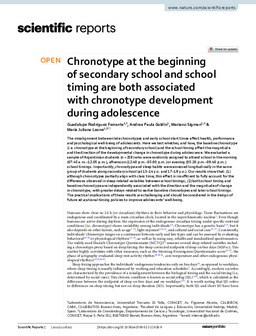Mostrar el registro sencillo del ítem
Chronotype at the beginning of secondary school and school timing are both associated with chronotype development during adolescence
| dc.rights.license | https://creativecommons.org/licenses/by-sa/2.5/ar/ | es_AR |
| dc.contributor.author | Goldín, Andrea Paula | es_AR |
| dc.contributor.author | Sigman, Mariano | es_AR |
| dc.contributor.author | Rodríguez Ferrante, Guadalupe | es_AR |
| dc.contributor.author | Leone, María Juliana | es_AR |
| dc.contributor.editor | Scientific Reports | |
| dc.date.accessioned | 2022-11-28T22:13:39Z | |
| dc.date.available | 2022-11-28T22:13:39Z | |
| dc.date.issued | 2022 | |
| dc.identifier.citation | Rodríguez Ferrante, G., Goldin, A.P., Sigman, M. et al. Chronotype at the beginning of secondary school and school timing are both associated with chronotype development during adolescence. Sci Rep 12, 8207 (2022). https://doi.org/10.1038/s41598-022-11928-9 | |
| dc.identifier.uri | https://repositorio.utdt.edu/handle/20.500.13098/11461 | |
| dc.identifier.uri | https://doi.org/10.1038/s41598-022-11928-9 | |
| dc.description.abstract | The misalignment between late chronotypes and early school start times affect health, performance and psychological well-being of adolescents. Here we test whether, and how, the baseline chronotype (i.e. chronotype at the beginning of secondary school) and the school timing affect the magnitude and the direction of the developmental change in chronotype during adolescence. We evaluated a sample of Argentinian students (n = 259) who were randomly assigned to attend school in the morning (07:45 a.m.–12:05 p.m.), afternoon (12:40 p.m.–05:00 p.m.) or evening (05:20 p.m.–09:40 p.m.) school timings. Importantly, chronotype and sleep habits were assessed longitudinally in the same group of students along secondary school (at 13–14 y.o. and 17–18 y.o.). Our results show that: (1) although chronotypes partially align with class time, this effect is insufficient to fully account for the differences observed in sleep-related variables between school timings; (2) both school timing and baseline chronotype are independently associated with the direction and the magnitude of change in chronotype, with greater delays related to earlier baseline chronotypes and later school timings. The practical implications of these results are challenging and should be considered in the design of future educational timing policies to improve adolescents’ well-being. | es_AR |
| dc.description.sponsorship | Scientific Reports | |
| dc.format.extent | p.1-14 | es_AR |
| dc.format.medium | application/pdf | es_AR |
| dc.language | spa | es_AR |
| dc.publisher | Scientific Reports | es_AR |
| dc.rights | info:eu-repo/semantics/openAccess | es_AR |
| dc.subject | Chronotype | es_AR |
| dc.subject | School Timing | es_AR |
| dc.subject | Adolescence | es_AR |
| dc.title | Chronotype at the beginning of secondary school and school timing are both associated with chronotype development during adolescence | es_AR |
| dc.type | info:eu-repo/semantics/article | es_AR |
| dc.type.version | info:eu-repo/semantics/publishedVersion | es_AR |

